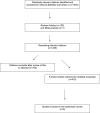Hepatitis C virus infection and kidney disease: a meta-analysis
- PMID: 22403269
- PMCID: PMC3315338
- DOI: 10.2215/CJN.06920711
Hepatitis C virus infection and kidney disease: a meta-analysis
Abstract
Background and objectives: Hepatitis C virus (HCV) infection and kidney disease are both highly prevalent diseases. The association between HCV and GN has been supported by previous research but little is known about the relationship between HCV and kidney disease.
Design, setting, participants, & measurements: A systematic review of the published medical literature was conducted to determine if HCV is associated with increased likelihood of kidney disease in the general population. A random-effects model was used to generate a summary estimate of the relative risk for kidney disease, defined as an estimated GFR <60 ml/min per 1.73 m(2) or proteinuria, with HCV across the published studies.
Results: Nine clinical studies (817,917 unique individuals) were identified. Pooling of study results demonstrated the absence of a relationship between HCV seropositive status and reduced estimated GFR (adjusted relative risk, 1.12; 95% confidence interval, 0.91, 1.38; P=0.28) according to the random-effects model. HCV seropositive serology was an independent and significant risk factor for proteinuria (defined by urine dipstick test or spot urine albumin/creatinine ratio) in the general population, with a summary estimate for adjusted relative risk of 1.47 (95% confidence interval, 1.12, 1.94; P=0.006). Significant heterogeneity was observed between studies (Ri=0.82; P value by Q test, <0.001).
Conclusions: This meta-analysis shows that HCV is independently associated with proteinuria but not with reduced GFR in the general population. Substantial heterogeneity occurred.
Figures


Similar articles
-
Association Between Hepatitis C Virus and Chronic Kidney Disease: A Systematic Review and Meta-Analysis.Ann Hepatol. 2018 May-June;17(3):364-391. doi: 10.5604/01.3001.0011.7382. Epub 2018 Apr 9. Ann Hepatol. 2018. PMID: 29735788
-
Hepatitis C virus increases the risk of kidney disease among HIV-positive patients: Systematic review and meta-analysis.J Med Virol. 2016 Mar;88(3):487-97. doi: 10.1002/jmv.24353. Epub 2015 Oct 8. J Med Virol. 2016. PMID: 26271205 Review.
-
Association of Hepatitis C Virus Infection with Proteinuria and Glomerular Filtration Rate.Clin Transl Sci. 2015 Oct;8(5):421-4. doi: 10.1111/cts.12321. Epub 2015 Aug 14. Clin Transl Sci. 2015. PMID: 26272111 Free PMC article.
-
Hepatitis C Virus Infection Increases the Risk of Developing Chronic Kidney Disease: A Systematic Review and Meta-Analysis.Dig Dis Sci. 2015 Dec;60(12):3801-13. doi: 10.1007/s10620-015-3801-y. Epub 2015 Jul 21. Dig Dis Sci. 2015. PMID: 26195311 Review.
-
Hepatitis C virus infection is associated with proteinuria according to a systematic review with meta-analysis.Nefrologia (Engl Ed). 2024 Jul-Aug;44(4):486-495. doi: 10.1016/j.nefroe.2024.01.021. Nefrologia (Engl Ed). 2024. PMID: 39216980
Cited by
-
Renal function trajectories in hepatitis C infection: differences between renal healthy and chronic kidney disease individuals.Sci Rep. 2021 Aug 25;11(1):17197. doi: 10.1038/s41598-021-96782-x. Sci Rep. 2021. PMID: 34433887 Free PMC article. Clinical Trial.
-
Hepatitis C virus infection increases risk of developing end-stage renal disease using competing risk analysis.PLoS One. 2014 Jun 27;9(6):e100790. doi: 10.1371/journal.pone.0100790. eCollection 2014. PLoS One. 2014. PMID: 24971499 Free PMC article.
-
Chronic hepatitis C virus (HCV) increases the risk of chronic kidney disease (CKD) while effective HCV treatment decreases the incidence of CKD.Hepatology. 2018 Feb;67(2):492-504. doi: 10.1002/hep.29505. Epub 2017 Dec 23. Hepatology. 2018. PMID: 28873225 Free PMC article.
-
The Association between Helicobacter pylori Infection and Chronic Hepatitis C: A Meta-Analysis and Trial Sequential Analysis.Gastroenterol Res Pract. 2016;2016:8780695. doi: 10.1155/2016/8780695. Epub 2016 Jan 24. Gastroenterol Res Pract. 2016. PMID: 26904112 Free PMC article. Review.
-
Hepatitis C and its impact on renal transplantation.Nat Rev Nephrol. 2015 Mar;11(3):172-82. doi: 10.1038/nrneph.2015.5. Epub 2015 Feb 3. Nat Rev Nephrol. 2015. PMID: 25643666 Review.
References
-
- Kim WR: The burden of hepatitis C in the United States. Hepatology 36: S30–S34, 2002 - PubMed
-
- Kidney Disease: Improving Global Outcomes (KDIGO): KDIGO clinical practice guidelines for the prevention, diagnosis, evaluation, and treatment of hepatitis C in chronic kidney disease. Kidney Int 73[Suppl 109]: S1–S99, 2008 - PubMed
-
- Covic A, Abramowicz D, Bruchfeld A, Leroux-Roels G, Samuel D, Van Biesen W, Zoccali C, Zoulim F, Vanholder R, ERA-EDTA ERBP Advisory Board : Endorsement of the Kidney Disease Improving Global Outcomes (KDIGO) hepatitis C guidelines: A European Renal Best Practice (ERBP) position statement. Nephrol Dial Transplant 24: 719–727, 2009 - PubMed
-
- Daghestani L, Pomeroy C: Renal manifestations of hepatitis C infection. Am J Med 106: 347–354, 1999 - PubMed
-
- Bergman S, Accort N, Turner A, Glaze J: Hepatitis C infection is acquired pre-ESRD. Am J Kidney Dis 45: 684–689, 2005 - PubMed
Publication types
MeSH terms
LinkOut - more resources
Full Text Sources
Medical

